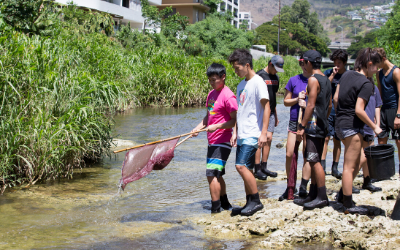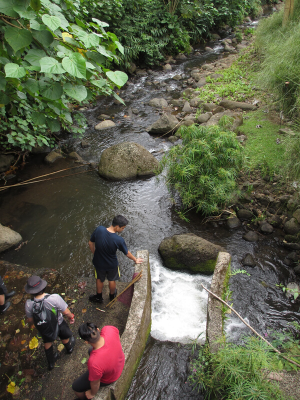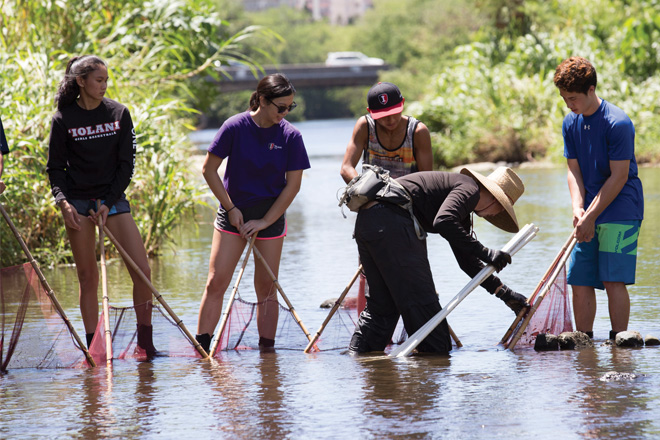Interview by Cecily Garber
Feature image: Students from 'Iolani School Participating in a collaborative citizen science project funded by the E.E. Ford Foundation. Photo courtesy of the school.
John Gulla is executive director at the Edward E. Ford Foundation, which makes grants to independent schools throughout the U.S. with a focus on students in grades 9–12.
Net Assets: For its larger grants, the Edward E. Ford Foundation requires that schools collaborate with other schools or work on a project that will impact a broad swath of schools. Why is collaboration important to the foundation?
John Gulla: I think that one of the most promising structural opportunities for the nation-wide network of independent schools is to harness a level of collaboration that doesn't exist now as fully as I think it could. Here’s an analogy: If you were Uber and I was Lyft, we wouldn't share any secrets or be inclined to help one another. In fact, part of our job would be to put each other out of business. But that working style is not in the nature of those drawn to education, who tend to be more generous of soul and inclined to collaboration. We are not limited by the tyrannical goal of maximization of profit, and this can be our competitive advantage.
Net Assets: Can you give some examples of independent schools collaborating in productive ways?
Gulla: The first example that comes to mind is now called the Bay Area BlendEd Consortium, a blended learning effort — that is, courses with both online and in-person components — for which we funded some of the startup costs. College Prep led the charge and was joined by Lick-Wilmerding, The Athenian School, Marin Academy and Urban School of San Francisco, which were later joined by Branson and San Francisco University High School. They wanted to offer a slate of blended courses that were broader and deeper than what any one school might be able to offer alone, and they wanted some economy of scale on the administrative side. So they came together to develop a curriculum of blended courses with a minimum number of in-person meetings per semester.
Even though many of their respective families all live in the Bay area and could commute to one of the other schools — they were in effect competing for students — the schools trusted each other enough to collaborate to improve the experience for a number of their students.
The schools reported it was a beneficial project for many reasons, including ancillary collaborative efforts. Monique DeVane, the head of school at College Prep, said that in part due to this collaborative effort the schools developed a "trust economy." Even though many of their respective families all live in the Bay area and could commute to one of the other schools — they were in effect competing for students — the schools trusted each other enough to collaborate to improve the experience for a number of their students. Perhaps they’re better able to do this because San Francisco schools have plenty of demand. It might not have been as easy to pull off in Philadelphia or Baltimore or St. Louis or Detroit, where the supply of seats in top-notch independent schools may exceed demand, at least from full-pay families.

Net Assets: What about examples of independent schools collaborating with public schools or other types of institutions? Does that ever work?
Gulla: We recently made an exciting leadership grant to ‘Iolani School in Honolulu. ‘Iolani is leading an effort in citizen science, which is when everyday citizens who aren’t professional research scientists contribute to professional research projects. In ‘Iolani's case, secondary students are involved with genomic research regarding primitive organisms found in the lava tubes throughout the Hawaiian Islands.
‘Iolani has the equipment and the resources to do the work alone, but it’s partnering with other independent schools — some faith-based, some non-sectarian — and a number of public schools in and around Honolulu to train students to sequence the DNA of samples, do the genomic research and then contribute the data to studies conducted at the University of Hawaii. The high school kids are very excited to be doing this. Through their collective efforts, the students are literally contributing some of the building blocks of evidence-based empirical science. We're keenly interested in these kinds of projects.
Net Assets: That sounds fantastic. I can see how the citizen science project enriches the students' experience. But thinking selfishly, is there any benefit that ‘Iolani gets out of the collaboration in terms of impact or name recognition?

Gulla: I think “yes” is the answer. Tim Cottrell, ‘Iolani’s head of school, is one of the enlightened leaders of a large, well-resourced school who sees the public purpose of his private school. I believe he'd make the case that a number of ‘Iolani students are keenly interested in research science careers, and the school has pursued this public/private partnership, in part, to provide ‘Iolani students with field experience. It's leading to summer internships and to students’ growing enthusiasm for possible majors they might pursue in college.
In addition, the school has allowed other schools to draft off its leadership effort and get involved in “doing science.” Without collaborating, many of the partner schools wouldn't have the resources to buy the equipment to do this genomic research. They wouldn't have the staff to be able to repair the equipment. ‘Iolani has a number of people who could be teaching at the college level, but they're choosing to teach at ‘Iolani — and ‘Iolani is sharing those resources. ‘Iolani is trying to support the pathway forward for some of the students in those schools. It's an honest and genuine commitment to education that goes beyond one school.
Net Assets: That brings to mind the debates in the U.K. and Australia about the place of private schools in society. Some people are resentful that such a large proportion of government leaders and others in top income brackets attended private school. Last September, the Labour Party in Britain went so far as to pass a resolution to ban private schools, meaning ending tax privileges and seizing assets, which the party would implement if it controlled the government. That’s not the current environment in the U.S., but I can see how a private school’s public-oriented vision can be important for public relations.
Gulla: Right. I'm sure you're aware that debate does exist here in the U.S., if not as pronounced as it is in the U.K. One of the strongest arguments in the U.S. against private schools is that if there were no private schools, then the highly influential moneyed classes would take greater interest in public education, and it would improve as a result. I don't dismiss that argument, but there are counter arguments.
I spent 35 years working in independent schools before joining the foundation, and during those years, most of my focus was on the specific schools that employed me at the time. Since leading E.E. Ford, I've visited over 450 schools in approximately 40 states, so now I have a much fuller appreciation of just how varied mission-driven schools can be. I was an advocate for independent schools before I started here, but I am a much more informed and avid advocate now. I see how individual schools that coalesce around a particular mission can get after their work with allied constituent groups in more effective ways without some of the political impediments. Individual schools really do have different cultures, and they're serving kids in an incredibly positive way as a result, at least in part, of not trying to be all things to all people.
Individual schools really do have different cultures, and they're serving kids in an incredibly positive way as a result, at least in part, of not trying to be all things to all people.
I've never worked in public schools in part because I'm not a believer in the kind of bureaucratic political hamstringing of schools that can take place in that sector. I do think they do good work. I'm not only the son of two public school teachers, but I also grew up in an extended Italian-Irish Catholic family outside of Boston with lots of aunts and uncles, every one of whom was a public school educator. I'm not one who thinks there needs to be a tension-filled competition between the two. I think we can harmoniously coexist. There are a lot of inspired, dedicated people in our public schools who are serving our democratic society really well.
Net Assets: Another important outcome for those that receive your larger grants is that schools influence democratic society, right? I’d love to hear more about how independent schools are innovating in that regard.
Gulla: One of the challenges that many school heads will speak to, especially heads of schools that have considerable resources, is that people in their geographic area may have a limited understanding about the privilege and exclusivity of their school. They'll say, “I wish everybody didn't think of us only as this bastion of privilege, as this exclusive elitist school on the hill.”
I have a response that’s a bit complicated, but I’ll try to explain it succinctly. Let’s take NAIS schools. They enroll just 1% of all students in the U.S. The non-publics educate about 10% of all students, but NAIS schools are only about a tenth of this number, so that’s about 1%. Let’s say we take the 100 “best” colleges and universities in the U.S., however you want to define “best.” I think you’d see that about 30% of the student population at those colleges would have graduated from NAIS schools. This is much higher than the 1%, of course, that their numbers represent.
Now, let’s think about the percentage of all students at NAIS schools who are able to attend because they receive need-based aid. My guess is that about one-third of all NAIS seniors receive need-based aid. This is a proxy for some level of socio-economic diversity. If you then were to combine these two numbers, you might predict that 10% (one-third of 30%) of the students matriculating at the 100 “best” colleges and universities are NAIS alumni who are receiving need-based financial aid. If we had the actual data, I bet the percentage would be much higher than 10%. I believe the data would show that independent schools are some of our most effective engines of social mobility in an increasingly rigid and class-immobile society.
Net Assets: That’s interesting, especially because many independent schools are worried about losing their middle-class families.
Gulla: Hold on. There’s one more piece to this idea. Anthony Jack, a Harvard professor, last year published a book called “The Privileged Poor: How Elite Colleges Are Failing Disadvantaged Students.” Jack makes the case that one of the challenges those students have when they arrive in the privileged enclaves of Ivy League colleges and other similar institutions is that they're exposed to degrees of wealth and privilege that they might not have previously experienced. He considers those students to have been “doubly disadvantaged,” whereas economically disadvantaged students who had been to an independent school had already dealt and come to terms with some of those challenges.
Independent schools enable students to develop some of the social capital necessary to navigate that world. It’s a mistake to think of independent schools as providing just the academic preparation for a top-notch college. It’s also about what it means to students to live in that world.
I have been talking and writing lately about “the danger of a single story,” an idea introduced by the Nigerian author Chimamanda Ngozi Adichie, but I use it with regard to independent schools. Most people only think of independent schools as bastions of privilege and they are that, but they are more than that as well. They are also communities of unlimited opportunity for many.
Download a PDF of this article.



